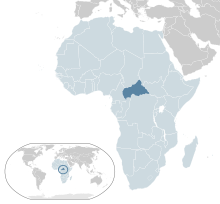| 2001 Central African Republic coup d'état attempt | |||||||
|---|---|---|---|---|---|---|---|
 | |||||||
| |||||||
| Belligerents | |||||||
|
Congolese rebels [3] | Army faction | ||||||
| Commanders and leaders | |||||||
|
Ange-Felix Patasse Abel Abrou † Francois N'Djadder Bedaya † | Francois Bozize | ||||||
| Casualties and losses | |||||||
|
At least 59 killed in initial coup attempt.
[5] Around 300 Yakoma civilians murdered following coup [6] | |||||||
On the night of 27–28 May 2001 a coup attempt was carried out by commandos of the Central African Armed Forces who attempted to overthrow Ange-Félix Patassé. The coup attempt failed, but violence continued in the capital over the following days. [7]
The coup was sponsored by André Kolingba and had the effect of dividing the country's armed forces into two opposing camps: one that supported Patassé and the other that supported François Bozizé. [8] While the coup failed, the Central African chief of staff Abel Abrou and general Francois N'Djadder Bedaya were killed. [9]
See also
References
- ^ International Crisis Group. "Central African Republic: Anatomy of a Phantom State" (PDF). CrisisGroup.org. International Crisis Group. Archived from the original (PDF) on 26 June 2014. Retrieved 24 July 2014.
- ^ BBC (20 April 2011). "Central African Republic profile - Timeline". BBC News. Retrieved 26 July 2015.
- ^ BBC (20 April 2011). "Central African Republic profile - Timeline". BBC News. Retrieved 26 July 2015.
- ^ International Crisis Group. "Central African Republic: Anatomy of a Phantom State" (PDF). CrisisGroup.org. International Crisis Group. Archived from the original (PDF) on 26 June 2014. Retrieved 24 July 2014.
- ^ BBC (20 April 2011). "Central African Republic profile - Timeline". BBC News. Retrieved 26 July 2015.
- ^ International Crisis Group. "Central African Republic: Anatomy of a Phantom State" (PDF). CrisisGroup.org. International Crisis Group. Archived from the original (PDF) on 26 June 2014. Retrieved 24 July 2014.
- ^ International Crisis Group. "Central African Republic: Anatomy of a Phantom State" (PDF). CrisisGroup.org. International Crisis Group. Archived from the original (PDF) on 26 June 2014. Retrieved 24 July 2014.
- ^ "Colonialism, Coups and Conflict: Understanding Today's Violence in the Central African Republic". 2 February 2015.
- ^ Compilation of the information available in the Global IDP Database of the Norwegian Refugee Council. Norwegian Refugee Council/Global IDP Project. 2005.
| 2001 Central African Republic coup d'état attempt | |||||||
|---|---|---|---|---|---|---|---|
 | |||||||
| |||||||
| Belligerents | |||||||
|
Congolese rebels [3] | Army faction | ||||||
| Commanders and leaders | |||||||
|
Ange-Felix Patasse Abel Abrou † Francois N'Djadder Bedaya † | Francois Bozize | ||||||
| Casualties and losses | |||||||
|
At least 59 killed in initial coup attempt.
[5] Around 300 Yakoma civilians murdered following coup [6] | |||||||
On the night of 27–28 May 2001 a coup attempt was carried out by commandos of the Central African Armed Forces who attempted to overthrow Ange-Félix Patassé. The coup attempt failed, but violence continued in the capital over the following days. [7]
The coup was sponsored by André Kolingba and had the effect of dividing the country's armed forces into two opposing camps: one that supported Patassé and the other that supported François Bozizé. [8] While the coup failed, the Central African chief of staff Abel Abrou and general Francois N'Djadder Bedaya were killed. [9]
See also
References
- ^ International Crisis Group. "Central African Republic: Anatomy of a Phantom State" (PDF). CrisisGroup.org. International Crisis Group. Archived from the original (PDF) on 26 June 2014. Retrieved 24 July 2014.
- ^ BBC (20 April 2011). "Central African Republic profile - Timeline". BBC News. Retrieved 26 July 2015.
- ^ BBC (20 April 2011). "Central African Republic profile - Timeline". BBC News. Retrieved 26 July 2015.
- ^ International Crisis Group. "Central African Republic: Anatomy of a Phantom State" (PDF). CrisisGroup.org. International Crisis Group. Archived from the original (PDF) on 26 June 2014. Retrieved 24 July 2014.
- ^ BBC (20 April 2011). "Central African Republic profile - Timeline". BBC News. Retrieved 26 July 2015.
- ^ International Crisis Group. "Central African Republic: Anatomy of a Phantom State" (PDF). CrisisGroup.org. International Crisis Group. Archived from the original (PDF) on 26 June 2014. Retrieved 24 July 2014.
- ^ International Crisis Group. "Central African Republic: Anatomy of a Phantom State" (PDF). CrisisGroup.org. International Crisis Group. Archived from the original (PDF) on 26 June 2014. Retrieved 24 July 2014.
- ^ "Colonialism, Coups and Conflict: Understanding Today's Violence in the Central African Republic". 2 February 2015.
- ^ Compilation of the information available in the Global IDP Database of the Norwegian Refugee Council. Norwegian Refugee Council/Global IDP Project. 2005.